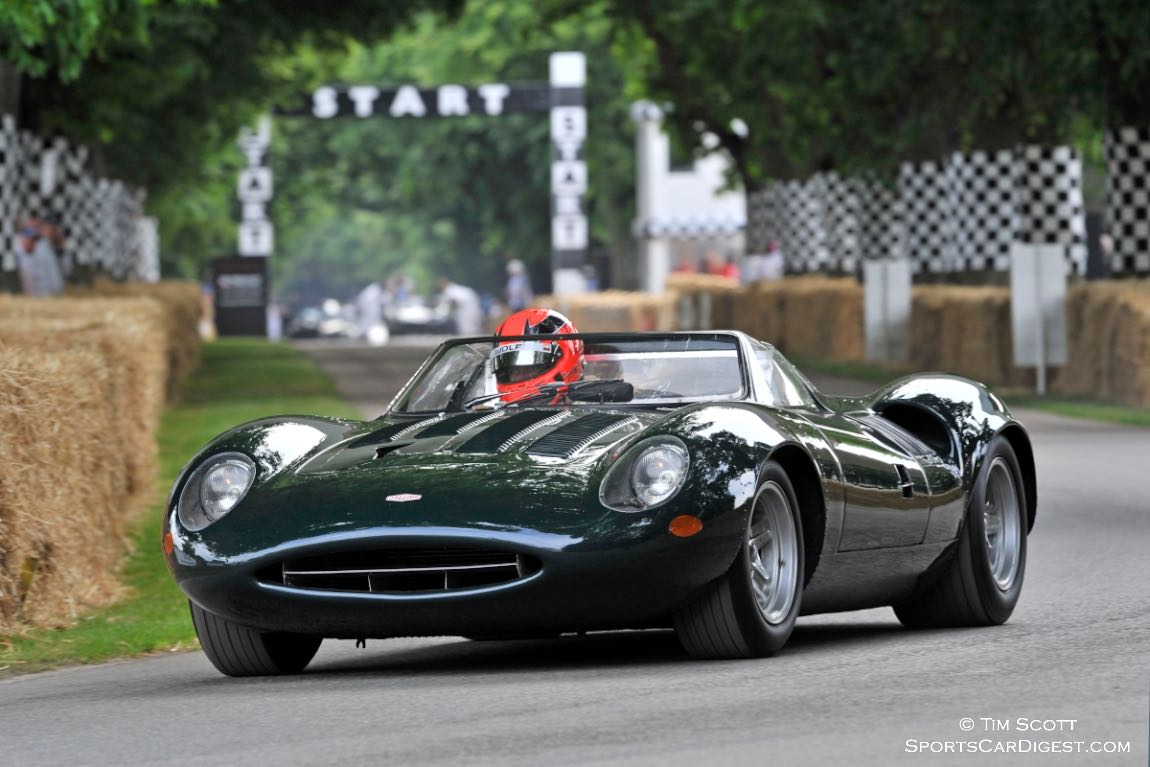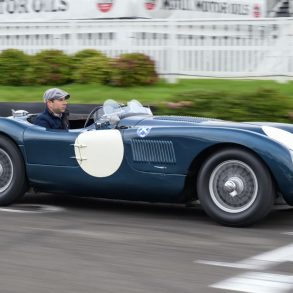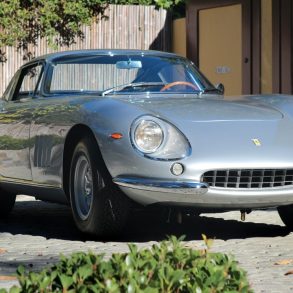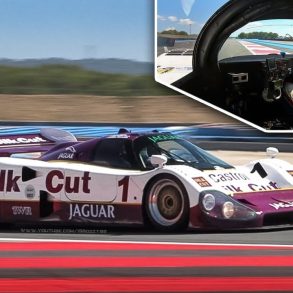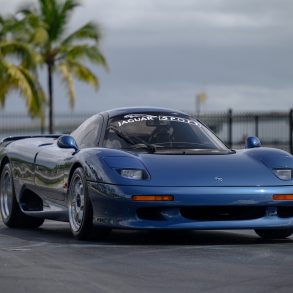The Jaguar XJ13, a one-off sports prototype, was produced to take on the dominating Ferrari and Ford at Le Mans in the 1960s and launch Jaguar back to its rightful place on the winner’s podium. Unfortunately, to no fault of them, this astonishing vehicle never got the opportunity to test its performance on the track. To tell the marvelous story of the Jaguar XJ13 we need to go back to when it all began.
Jaguar XJ13 racing at 2015 Goodwood Festival of Speed. Source: YouTube
Childhood Friends, Lyons and Walmsley Create Jaguar
On 4 September 1922, two young motorcycle enthusiasts in Blackpool, England, William Walmsley, 30, and William Lyons, 20, created a partnership that eventually would be known around the world by the name, Jaguar.
The two men had known each other since childhood and lived on the same street in Blackpool. Wamsley ran a small business making sidecars and bolted them onto reconditioned motorcycles. Lyons recognized the commercial potential for Wamsley’s sidecars and, upon turning the legal age of 21 on 4 September 1922, the two created a new company called the Swallow Sidecar Company.

In May 1927, Lyons and Walmsley decided to step up their production to manufacture sports saloon automobiles and the name “Sidecar” was dropped. The men thought the name Swallow Coachbuilding Company was more visually distinctive and adopted with the acronym, SS, for all their new vehicles.
The first automobile produced in a reasonable quantity was the Austin Seven Swallow. Priced at a meager £175, the inexpensive Austin had a brightly colored two-tone body and styling that looked more expensive than most other cars at the time. The Austin Seven Swallow immediately became popular in the prosperous late 1920s and the following depression.

In 1935, the company sold the sidecar manufacturing business and changed the company name again, this time to S.S. Cars Limited to maintain some similarity with the previous company.
One year later, in September 1936, the first Jaguar vehicle was produced. Lyons felt the name “Jaguar” reflected the feline nimbleness of their stylish new 2.5-liter low-slung SS saloon car models. The car became an immediate success in the English automobile market.
Along with the SS, Lyons introduced a matching two-seat sports model with a larger 3½-liter engine called the SS Jaguar 100, based on the automobiles theoretical maximum speed of 100 mph.

In September 1939, Nazi Germany invaded Poland, marking the beginning of World War II. The Nazi leader, Adolph Hitler, was protected by numerous personal bodyguards known as the Schutzstaffel, or “S.S.”, German for “Protective Echelon”. Hitler’s “S.S.” soon became the most powerful and feared organization in Germany.
Lyons wanted to distance the company from being connected to Hitler’s S.S. bodyguards and, on 23 March 1945, he had the name of the company changed to Jaguar Cars Limited. In announcing the change, he said the new name Jaguar was distinctive and “would not be connected or confused with any similar foreign name.”
After the war ended, the new company became known as a prestige motorcar manufacturer with few rivals. This was a remarkable achievement considering the vast shortage of raw materials available in Britain after the war.
Jaguar Sports Cars Dominates Racing
Jaguar soon began producing a number of attractive sports cars that were particularly successful in international motorsports. Lyons claimed that racing proved the engineering integrity of the company’s products.
In 1949, the company presented the first vehicle that truly put the brand on the automotive map: the sleekly styled Jaguar XK120. Equipped with a new dual overhead camshaft (DOHC) and the company’s inline six-cylinder XK engine, the new vehicle was considered a great road-racing car.
Jaguar was dominating racing in the 1950s and was a force to be reckoned with. In 1953, the C-Type works cars achieved tremendous successes by finishing in first, second, fourth, and ninth place at the Le Mans 24-Hour endurance race. Drivers Duncan Hamilton and Tony Rolt completed the event at an average speed of over 100 mph for the first time in history.

The next model, the D-Type, received a power boost over the previous C-Type, a new monocoque chassis, and a sleek new aerodynamic body. The vehicle reached over 170 mph on the Le Mans Mulsanne Straight and took first place at successive Le Mans in 1955, 1956, and 1957.
The Creation of the Jaguar XJ13
In 1960, William Heynes, the Engineering Director, led a new project to build a mid-engine prototype racing vehicle, the experimental Jaguar 13. The new car was renamed the Jaguar XJ13 and was specially developed with the primary purpose of winning at Le Mans during the mid-1960s.


Heynes began immediately to work on designing the structure of the model. However, the actual construction did not begin until 1965. The first running example of the vehicle began testing in March 1966.
Chassis Design
The XJ13 was based around a new aluminum monocoque chassis with a 95-inch (2410 mm) wheelbase. The engine and gearbox carried the rear suspension while a bolt-on subframe assembly was used in the front.
A double-wishbone front suspension and upper transverse links, similar to the E-type, were used in the rear of the vehicle. A pair of radius arms with a single transverse lower link was placed on each side. The car also featured coil-sprung Armstrong dampers all around.

Handsome five-spoke magnesium alloy wheels were fitted on all four wheels. The vehicle used 15 x 7-inch on the front and 15 x 9-inch on the rear. Dunlop D7 racing tires were used with vented disc brakes measuring 12 inches (303 mm) on the front and 11.6-inches (295 mm) at the rear.
Two exceptionally large fuel tanks with a combined capacity of 49 gallons (86.4 liters) were fitted on each side of the engine bay and against the rear bulkhead.
In 2015, the Australian TV Show ‘Car Torque’ interviewed Aaron Lewis, an owner of a limited edition replica built by the New Zealand–based company Tempero Coach and Motor Co. Ltd. Lewis did a phenomenal job at taking you through details of the XJ13 specifications.
V12 Engine of the XJ13
The vehicle’s engine was an all-aluminum 60° V12 designed by engineer Claude Bailey. It was essentially two XK six-cylinder engines connected to a common crankshaft. Engineers decided to make some small modifications to the inlet ports, valve angles, and the shape of the combustion chambers.


The new engine used dry-sump lubrication, dual overhead camshafts, and a Lucas OPUS ignition system. A bore and stroke of 87 mm and 70 mm resulted in engine displacement of 4994 ccs and a compression ratio of 10.4:1.
Originally, the engine featured six SU side-draft carburetors to develop 445 bhp at 7000 rpm. The company soon switched to Lucas mechanical fuel injection, resulting in an increase to 503 bhp at 7600 rpm and peak torque of 382 lb-ft at 6300 rpm. The engineers claimed that with further development, the engine could have achieved another 200bhp.
The first engine was tested in July 1964 using a five-speed manual ZF 5DS-25 transaxle. A chain-driven camshaft was used in the first few engines until engineers switched over to gear-driven cams in later versions. According to company records, seven prototype motors were eventually built.
Body and Design
Heynes gave the engineers Derick White, Ted Brookes, Bob Blake, and Mike Kimberley the task of constructing the car. The four worked in the competition shop of the Browns Lane Experimental Department.

The vehicle’s aluminum bodywork was designed by famed aerodynamicist Malcolm Sayer who had also been responsible for aerodynamic airflow work on both the C- and D-type cars. Sayer used his experience with the Bristol Aeroplane Company to build the car using techniques from the aircraft industry.
The vehicle stood a remarkable 39 inches (one meter) high and had a quite respectable low drag coefficient of 0.29, which compared favorably with race cars at the time offered by Ford and Ferrari.
A large oval intake was at the front of the vehicle designed to feed air directly into the car’s oversize radiator. The front lid featured a NACA duct and separate banks of four cooling louvers.
Two shoulder-mounted rear wing intakes directed fresh air into the XJ13 engine bay. Instead of a Kamm tail, used in most of the era’s racing cars, Sayer designed a pointed rear end that incorporated E-type taillights.
The four-cam V12 engine was neatly packaged under a clear Plexiglas cover with a basket handle rollover hoop attached to make it easily removed for quick access. The headlights also rested cleanly beneath Plexiglas covers.
The new vehicle featured aluminum bodywork fabricated by the Abbey Panels Company, located just down the road from the Coventry factory. One of the owners, Edward “Ted” Loades, had made the company famous for producing hand-made prototype car bodies for many British manufacturers. When the vehicle’s aluminum bodywork needed to be fabricated, they chose Loades’ company for the task.
The cockpit of the new XJ13 was designed without a roof. It featured two black vinyl bucket seats with vinyl bolsters and velour centers. Other cabin surfaces were painted aluminum.

The car’s 3-spoke steering wheel was wood-rimmed. Most of the dials and levers were placed in a pod ahead of the passenger seat and angled toward the driver. A large 10,000 rpm tachometer faced the driver from directly behind the steering wheel along with smaller gauges for fuel, oil pressure, and engine temperature. The 240 mph speedometer was strangely located around the side and away from the main bank of instrumentation. Most drivers said they found it almost impossible to read while driving.
Driving the XJ13
Heynes wanted Jack Brabham, an experienced racing driver to help develop the new car. The Formula One Champion was unavailable, so he chose David Hobbs, a young, ex-Jaguar Apprentice, who had experience driving at Le Mans driving for Triumph.

The prototype was slightly heavier than similar racing cars and weighed almost 2300 pounds (1040 kg). However, the vehicle could still reach 195 mph and speed from 0-62 mph in about 3.5 seconds.
Between March and August 1967, nine tests of the prototype were held at Silverstone and MIRA race tracks with Hobbs usually driving. In April 1967, at the 2.82 miles (4.53 km) MIRA track, Hobbs drove the car to an unofficial UK closed-lap record of 161.655 mph (260.15 km/h). The record held for 32 years until January 1999 when it was broken by Peter Taylor driving the new McLaren F1.
The Le Mans Bombshell
Without consulting any of the car manufacturers, the revised FIA regulations announced a three-liter engine limit would be imposed beginning in 1968 on all Group 6 Prototype racing cars. This was 2.0 liters less than the XJ13 V12 car was designed around. A large number of prototype vehicles became obsolete almost overnight, including the XJ13 and any prospect of the car racing at the track.
Following its final tests at Silverstone, the only existing vehicle was placed into storage under a dust cover until 1971 when it was planned to produce a promotional film for the company’s first V12-powered production vehicle, the Series 3 E-type.

The company publicity team wanted to use footage of the XJ13 running at high speed in the opening sequence. The XJ13 was rolled out to take part in the promotional film. It was fitted with a set of unused wheels on fresh tires and taken by truck to MIRA to be driven around the track by test driver Norman Dewis.
Unknown to Dewis, one of the vehicle’s lightweight magnesium wheels had corroded from the inside during storage. On his final lap, while the cameras were rolling, the wheel failed with catastrophic results. The car suffered a catastrophic crash against the retaining fence before rolling back onto the track and coming to rest.

The events of the dramatic crash are recalled by Norman Dewis in the following interview. (Source: YouTube)
Miraculously, Dewis was unharmed, but the vehicle suffered serious damage without a straight panel left on the body. The car was taken to storage facilities near the company factory where it stayed gathering dust for the next two years.
In 1973, Ted Loades of Abbey Panels spotted the crashed vehicle stored at Jaguar and offered to rebuild the vehicle using the original jigs. Lofty England, the head of their racing effort, agreed and the car was rebuilt by Abbey Panels to its original specifications. Loades charged the company a total of £1,000 for the restoration.
The newly restored XJ13 was taken to Silverstone and made its debut at the July 1973 British Grand Prix where it was driven around the track at the British Grand Prix by Lofty England for several parade laps.
It remains in working order and makes demonstration appearances at various vintage events.
Jaguar’s XJ13 would arguably become known as the most beautiful race car that never turned a wheel in competition. Today, the famous vehicle is a major attraction at the company’s Heritage Trust British Motor Museum in Gaydon, Warwickshire, in the UK.


